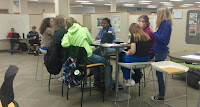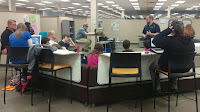Wow. Only 33 more days of school for this school year! The teachers are busy with testing season, final lesson plans, attempting to contain any spread of senioritis (which sometimes spreads to even the juniors!), and wrapping up any end of the year duties. So naturally, yesterday I had a great conversation with the about the beginning of next school year!



So just to recap- I work with a team of teachers in an open area concept learning space. We have couches, booths, small break out rooms, and high top seating to promote student selected small group learning. The students have online google classrooms where daily activities, projects, and assessments are assigned and submitted. The math teacher does a direct instruction session about once a week, English twice a week, Science twice a week, and Social Studies is almost exclusively online. Teachers have a projected calendar in the room as well as google calendars available through the online classroom to show all student assignments, due dates, and teacher scheduled pull out sessions. Next year we will have an English teacher, Social Studies teacher, Science teacher, Math teacher, Intervention Specialist with a full schedule. Due to course needs we will most likely have a second English teacher and Math teacher for part of the day. We can have up to 75 students in the morning and up to 75 students in the afternoon. When students and teachers are not in a classroom for direct instruction, students have access to their teachers for any help or guidance in the large area learning space.
Now the fun part. Remember the first day of school when the teachers would introduce themselves, go over the syllabus, explain the rules, etc.? Well in this space, we have to be a little more creative since there isn't a traditional schedule and so many teachers/students in one space, I imagine it would be best to split the responsibility of shared directions. Here are my thoughts out loud- I am sure things will change and evolve over the summer but these are the needs I see for first day/week instructions next year.
Google Classroom:

Students need to have a code provided by the teachers for the google classrooms. In this session, one teacher can help all students enroll in their classes and explore the information from each class. The students will have access to the class syllabus and can experiment with how to access an assignment, turn in an assignment, identify in an assignment is not completed, submitted, or late, as well as leave a comment for an assignment. One challenge this year for teachers, was identifying if a student turned in an assignment late after the teacher already entered grades for the assignment. We might come up with a shared practice of students commenting on the assignment so the teacher is alerted via email of the comment.
G-mail and Calendar:

Students should understand how to use google email, and google calendar. One teacher will give a mini session on how to combine all their classroom calendars (for due dates and direct instruction sessions), as well as how to add a new event. Students can even choose to sync the calendar to their phones.
Building Tour/ General Rules:

One teacher will go over the basics of the academic area as well as make sure students know where the bathrooms, water fountain, and cafeteria are. Typical classroom rules apply: respect for teachers, respect for peers, respect for space.
Google Docs:

Students will use google docs, slides, and sheets to submit their work online. For the most part, these are similar to Microsoft Word, Power Point and Excel, but it is important for students to understand how to share with others, access from Google Drive, and organize these assignments into folders.
Like I said, this was the gist of a conversation and a little but of just "thinking out loud." I am sure the first day ideas will change and evolve over summer. These tools will be beneficial to share and explain with students to start the school year successfully given the space and difference of learning compared to a traditional classroom.
Any other thoughts? Leave a comment! We would love to hear how others use a large space, flex time, and Google Apps for Education in the schools!
#NextGenHS
@MrsBKelley1
















